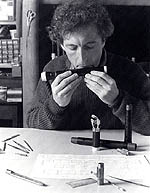
| Opus 42 - Baroque Flute |
|
|
His treatise on the flute, Versuch einer Anweisung die Flöte traversiere zu spielen ("On playing the transverse flute"), published in 1752 in Berlin, is one of the most extensive sources of information on the instrumental practice of that time. Quantz's flutes differed from Hotteterre's earlier models: they were made in four sections, had a second key, and were equipped with an internal slide between the head and middle joints so that the pitch could be lowered without unbalancing the tuning. Whereas Quantz's flute has six interchangeable joints, Jean-François Beaudin decided to reproduce the joint with a pitch of A=392, which was the most frequently played, as suggested by the wear on the holes. Beaudin also substituted plastic mounts for the ivory mounts on the original flute. The instrument maker's name is inscribed in a curve, often seen on baroque instruments, above a turtledove with open wings. Jean-François Beaudin identifies with the turtledove, which he feels symbolizes freedom; its introspective song is gentle but far-reaching and hauntingly mysterious, like the music of the baroque flute. Jean-François Beaudin 
the tuning on a flute, 1992. Musician and flute maker Jean-François Beaudin specializes in seventeenth- and eighteenth-century music. His virtuosity on the baroque flute and the recorder was developed at the Royal Conservatory of Music in The Hague. At this renowned school he was also introduced, by Australian instrument maker Frederick Morgan, to flute making and the art of drafting plans of early flutes. Thanks to three grants from the ministère des Affaires culturelles du Québec, Beaudin undertook a number of training stints and trips to examine collections of early instruments in order to study them and prepare inventories and plans. In addition to producing technical drawings for his own research, Beaudin has been commissioned to produce more than fifty technical drawings of instruments for the Musée instrumental du Conservatoire national supérieur de musique in Paris, the University of Edinburgh's Collection of Historic Musical Instruments, and the Musikinstrumenten-Museum des Staatlichen Instituts für Musikforschung in Berlin. With a solid fifteen years' experience at his craft, Jean-François Beaudin has made over one hundred instruments, including several flutes and recorders as well as flageolets, mainly for European clients. During a recent trip to India, he developed an interest in the Indian bamboo flute.
|
 |



